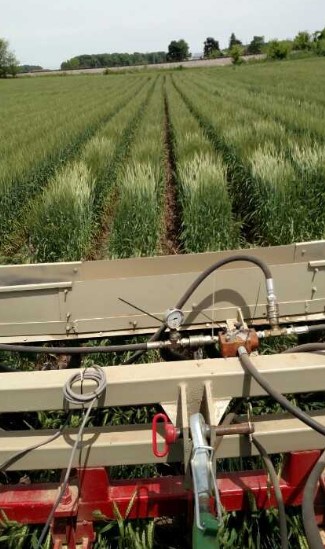By Jason Hartschuh
Spring planting is just around the corner and so is modified relay intercropping planting of soybeans into growing wheat. This is a very versatile system working across multiple row spacing’s and planting dates. Eighteen years of MRI soybean planting have been done in Bucyrus with wheat yields averaging 75 bushels per acre and soybean yields of 33 bushels per acre. Over the past 3 years we have had outstanding double crop soybeans, but MRI has out yielded them by about 10 bushels per acre averaging 42 bushels per acre. One challenge though is that straw cannot be baled in the MRI system but can be in double cropping. The lower price of soybeans and higher price of straw is driving more producers to double crop soybeans.
During these 18 years we have worked with multiple row spacing’s, seeding rates, and planting dates each with success and challenges. The easiest systems we have worked in is wide rows, either 15 inch or twin row wheat, wheat rows are 8 inches apart on 30 inch centers leaving a 22 inch gap. These two systems require much less equipment modifications and prior planning than 10 inch rows. In order to plant MRI soybeans in 10 inch wheat rows you should have planned ahead last fall and left tram lines, wheel passes in the field, where your tractor and planter tires can run.
Since your wheat is planted and row spacing is determined, we will focus on soybean management. We have seen soybean-planting dates from May 1st through mid-June with the most common planting date being late May through early June at Wheat Feekes growth stage 10.1 thought 10.5. The early May planting date only works in wide row wheat, this early planting date in 10-inch wheat leads to tall spindly soybeans that fall over after harvest. The best soybean yields have come from planting as close to Feekes 10.1 as possible, but planting much earlier than that often leads to tall soybeans that are clipped during wheat harvest. Some producers do prefer an early May/Late April planting date before wheat stem elongation, which allows for easier planting since the wheat is not damaged by planter tires driving over it. In order to manage the soybeans being as tall as the wheat at harvest producers are putting cutter guards on their grain head that pushes the soybeans down and protect them from the cutter bar. These producers are often also using special tires on their combines or at least using duals on the combine and straddling the soybeans rows. Early planted soybeans driven over at wheat harvest usually do not survive.

When selecting soybean varieties look for the highest yielding conventional variety. We have seen the highest yields from the longest season varieties for your area. Short season varieties start flowering to soon and usually do not achieve full canopy closer. Usually during MRI planting higher seeding rates of 200,000 seeds per acre is recommended because mice and insects that live in the wheat field feed on young soybean plants. As we have improved our planting equipment, we have also been able to decrease our recommended seeding rates from 250,000 to 200,000 seeds per acre. In our studies with early June seeding rates we have seen seeding rates of 150,000 seeds per acre maximize yields. The most important part when lowering your seeding rates is to make sure you have good planting equipment that creates good seed to soil contact protecting the seedlings during germination. If this is your first year intercropping, now is the time to take your planter to the field and make sure it fits through your wheat rows and make adjustments so that the planter does not drive over the wheat. You may also need to make spreaders that push the wheat away from your row units if they barely fit in the row since the wheat will be thicker by Feekes 10.5.